A wide variety of spider species are found across Oregon. In this article, we’ll look at 36 of the most common spiders you may encounter in Oregon.
As we move through the list they become progressively less easy to spot, but their fascinating characteristics make each one worth searching for.
Table of Contents
1. Cross Orbweaver
Scientific name: Araneus diadematus
Common name: European garden spider, orangie, crowned orb weaver, diadem spider, cross spider, cross orbweaver
Adult females can vary in length from 6.5mm to 20mm). Males are smaller, from 5.5mm to 13 mm.
They are reclusive. If they are disturbed, they’ll start vibrating in their web- so fast that they’ll become blurred. While it’s unknown why they do this, it’s assumed that predators will become confused.
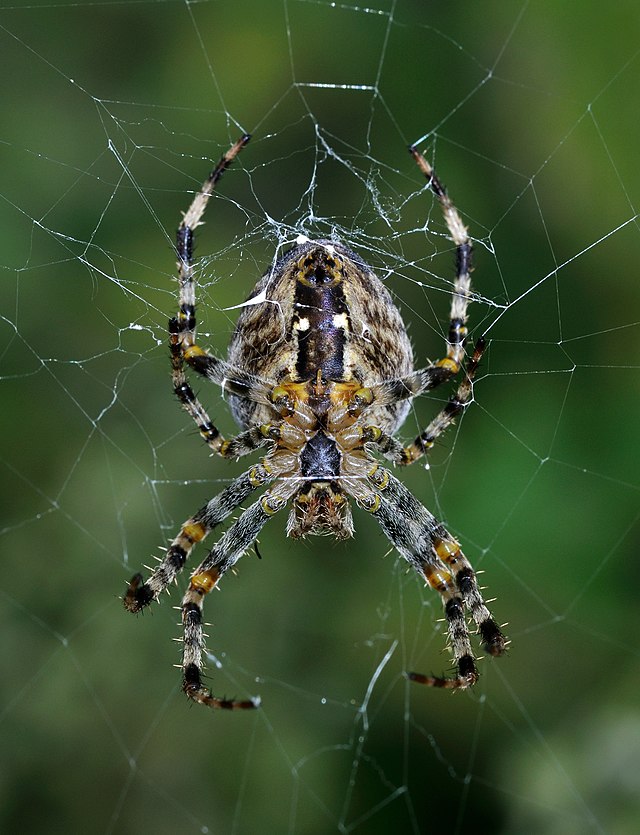
Females of this species will sometimes eat the male immediately after mating. This will depend on their relative size, their sexual experience, and how hungry they are.
2. Bold Jumping Spider

Scientific name: Phidippus audax
Common name: daring jumping spider, bold jumping spider
These jumping spiders are relatively large, ranging from 4mm-18mm. They’re easy to spot because of their iridescent chelicerae.
They are usually black with spots and stripes on their abdomen and legs.
In common with other jumping spiders, they have large, front-facing eyes, and keen stereoscopic vision. This gives them an edge when they’re stalking prey, and helps them make eye-contact with potential mates during courtship.
3. Zebra Jumping Spider

Scientific name: Salticus scenicus
Common name: zebra jumper, zebra jumping spider
Female zebra spiders are 5–9 mm in length, while males are 5–6 mm.
Their common name references their bold vivid black-and-white coloring.
Like all jumping spiders, they have 8 eyes, with the two front eyes being especially large. These often account for the unnerving feeling when humans feel that the spider is observing them – it probably is! But zebra jumping spiders are far more likely to be curious than aggressive.
4. Giant House Spider

Scientific name: Eratigena duellica
Common name: giant house spider
Females can reach 18.5 mm in length, while males have smaller bodies up to 15 mm long. Females have a leg span of around 45mm, while the length of male legs can be anything between 25mm to 75mm.
Although they are typically found inside dwellings, their bite is extremely rare. They prefer to escape or hide.
5. Goldenrod Crab Spider

Scientific name: Misumena vatia
Common name: flower (crab) spider, goldenrod crab spider
As the name suggests, this spider is typically found hunting among goldenrod blooms and milkweed plants.
Goldenrod Carb Spiders are usually yellow or white or a pattern of these two colors which provides camouflage among the flowers. They’re known as crab spiders because they can walk sideways as well as forwards and backward.
Females can be up to 10 mm long, while males are much smaller at no more than 5 mm.
Further Reading:
6. Yellow Garden Spider

Scientific name: Argiope aurantia
Common name: Black and yellow garden spider, writing spider, black and yellow argiope, zipper spider corn spider, zigzag spider Steeler spider, McKinley spider golden garden spider, yellow garden spider.
Females can grow to 19mm–28 mm, while males are much smaller at 5mm-9mm. Despite the multitude of names it grows by, this spider is easily identified by the yellow and black patterning on its abdomen and white cephalothorax.
Yellow garden spiders may bite if disturbed or threatened. However, their venom is harmless to non-allergic humans, similar to a bumblebee sting. No medical intervention is required, but it can be a good idea to apply an antiseptic to prevent the wound from becoming infected.
7. Mouse Spider

Scientific name: Scotophaeus blackwalli
Common name: gnaphose de blackwall, mouse spider
Adult female mouse spiders are around 12mm in length, while males are around 9mm. They mature in early summer and can be spotted until fall.
Their name derives from their dark brown carapace and brown/grey abdomen, which have hairs resembling the body of a mouse.
8. False Black Widow

Scientific name: Steatoda grossa
Common name: cupboard spider, the dark comb-footed spider, the brown house spider (in Australia) or the false widow or false black widow
Like true black widows, the female false black widow is typically 6-10.5 mm long, and dark-colored, with a bulbous abdomen. Although the male is often somewhat smaller than the female, in many cases he will be almost the same size, which is unusual among spiders. However, a male will be thinner than a female.
Typical colors range from deep, purple-tinged brown to black, possibly with light-colored markings.
Unlike true black widows, S. grossa doesn’t have a bright red or orange hourglass pattern on the underside of her abdomen, or any other bright markings.
False black widows will only bite when panicked or pressed against the skin (for example, if they’ve been hiding in shoes). Their bite, roughly equivalent to a wasp sting, isn’t dangerous to non-allergic humans or pets.
Further Reading:
9. Northern Yellow Sac Spider

Scientific name: Cheiracanthium mildei
Common name: northern yellow sac spider
Fully Grown Northern Yellow Sac Spiders typically range between 7mm–10mm in size. They can be identified by their pale green or light brown body, with darker brown palpi and chelicerae.
Their legs end in double claws, and the front pair is up to two times longer than the other three pairs.
Their eyes reflect light to a light source, which suggests that these spiders have keen eyesight – essential for active prey hunters, especially at night.
Although this spider can bite humans, there’s nothing to suggest anything more than mild effects.
10. Long-bodied Cellar Spider

Scientific name: Pholcus phalangioides
Common name: Daddy long-legs, skull spider, long-bodied cellar spider
Females are around 8 mm long with males typically slightly smaller. The spider’s legs can be 5 or 6 times its body length.
It lives on ceilings, garages, or in cellars. As it is known to attack and kill native spiders, this invasive species is considered very dangerous for native species. However, cellar spiders are harmless to humans.
11. Common Candy-striped Spider

Scientific name: Enoplognatha ovata
Common name: common candy-striped spider
This is an invasive species, originating in Europe (and most commonly found in Lithuania).
Its body can reach a length of 6 mm excluding its translucent legs. Its bulbous abdomen can be very varied in terms of color and markings. The base color may be white, cream, or green. It can be patterned with a row of dark spots, a wide red stripe, or even two red chevrons.
Although this is a relatively small spider, and harmless to humans, don’t be fooled! It is an awesome predator, which can seize and devour insects many times larger than itself.
12. Western Black Widow

Scientific name: Latrodectus hesperus
Common name: western black widow spider, western widow or western black widow
The female Western Black Widow’s body is typically 14–16 mm (1/2 in) long.
It is black, often with an hourglass or violin-shaped red mark on its lower abdomen. The mark can be yellow, or even white (though this is rare). The male of the species is around half this length and generally a light brown color with lighter stripes on its abdomen.
Of course, black widow spiders are notorious and their bites are often feared by humans. Symptoms of a western black widow bite could include pain, nausea, goosebumps, and sweating.
In the past, it was claimed that anything between 0.5% and 12% of bites was fatal. However, more recent studies (2000-2008) of over 23.000 reported bites did not confirm single mortality.
13. Silver-sided Sector Spider

Scientific name: Zygiella x-notata
Common name: missing sector orb weaver, silver-sided sector spider
The adult female silver-sided sector spider will typically be 5-11mm in length, while adult males can be around 7mm.
These are solitary spiders, constructing a fresh orb-web every day. They prefer to live near buildings and other human structures, and individuals may defend their ‘territory’ aggressively from other spiders who try to encroach on their preferred spot.
14. Banded Garden Spider

Scientific name: Argiope trifasciat
Common name: banded orb-weaving spider, banded garden spider
Female bodies are typically 5mm-6.5mm long although they can reach 13-14.5 mm when their legs are extended. The body of males is only around 1/3 to the length of that of the female.
They are daytime hunters, trapping prey in their strong, sticky webs which can reach a total length of two meters.
15. Woodlouse Spider

Scientific name: Dysdera crocata
Common name: woodlouse, sowbug or pillbug hunter, woodlouse spider and slater spider.
Adult females reach 11–15 mm in length, and males 9–10 mm.
As the name suggests they prey mainly on woodlice. They have also been found in houses. They tend to live in decaying wood, where they spend their days in crevices they partially block with their silk. Occasionally they build ‘tents’ in the gaps between large rocks.
Woodlouse spiders are nighttime hunters, and they don’t spin webs to catch their prey – instead, they use their powerful chelicerae to pierce the soft underbelly of the woodlouse. This enables them to evade their victim’s toxic defensive chemicals.
Woodlouse spiders may bite humans if they’re handled roughly. Their bites aren’t medically significant but may cause some localized itching.
16. Johnson’s Jumping Spider

Scientific name: Phidippus johnsoni
Common name: red-backed jumping spider, johnson’s jumping spider
This is one of the biggest commonly found jumping spiders in the USA. It is sometimes confused with the venomous redback spider (Latrodectus Hasselti), but the two are unrelated.
Adults are usually around 1cm in length. Although both sexes have a bright red abdomen, the female can be identified by her black central stripe.
Johnson’s Jumping Spider is one of those species that mimics mutillid wasps (more commonly known as “velvet ants”), resembling them in terms of size and color.
These spiders build tubular nests under rocks and wood, and sometimes in grapevines. They shelter inside these at night and when they need protection from bad weather.
They feed on roaches, mealworms, wax worms, and moths which are about half their size. If you keep them as pets, they need to be separate as they tend to eat each other.
17. Common House Spider

Scientific name: Parasteatoda tepidariorum
Common name: common house spider, American house spider
Females are typically 5 to 6 mm in length, while males are usually between 3.8 and 4.7mm. When their legs are extended, they can be 2.5 cm across.
Common house spiders are tangle web spiders that live in and close to human dwellings. They use their web to trap and paralyze their prey. Their diet consists of insects commonly considered household pests.
18. Nordmann’s Orbweaver
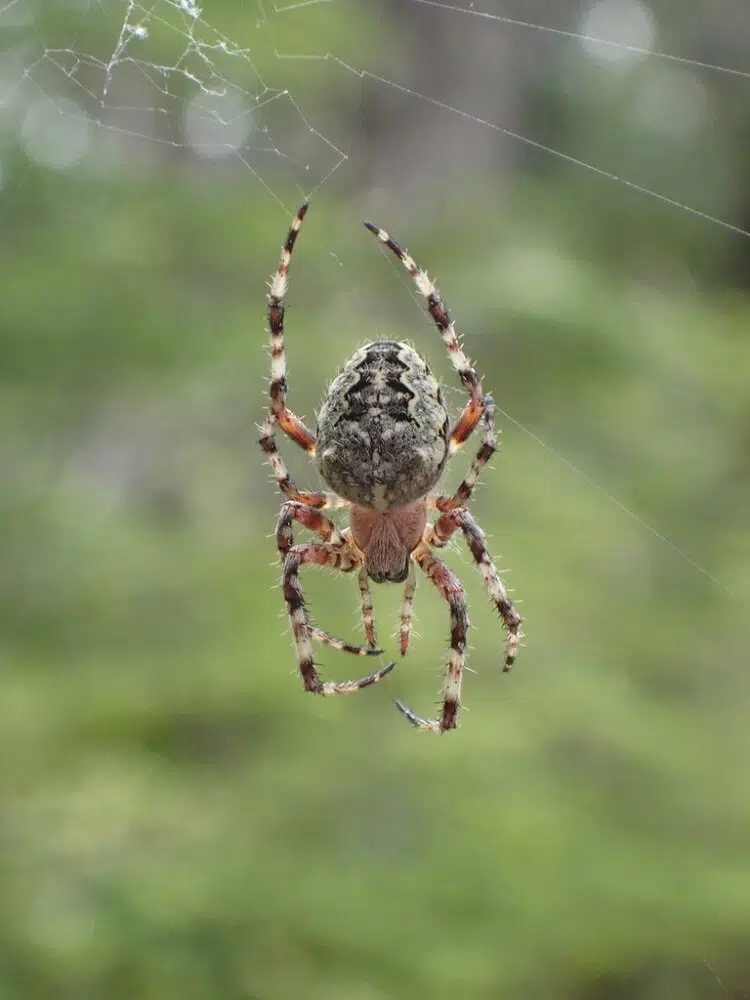
Scientific name: Araneus nordmanni
Common name: nordmann’s orbweaver
The females are 7-19 mm long, while males are smaller at 6-10 mm. They have a brown and white speckled abdomen, with shoulder humps
These spiders are live in greasy areas, spinning large flat webs that they use to catch their prey.
19. California Flattened Jumping Spider

Scientific name: Platycryptus californicus
Common name: California flattened jumping spider
These small spiders range between 6-11 mm in length – being so small they are easily mistaken for babies. They are identified by the grey leaf pattern is which is bordered by fluffy black or brown hair down their sides. Because of their petite nature, many people mistake them for babies.
Being so petite, they rely on speed to evade predators – when threatened, the first thing they’ll do is run away and hide. They prey on some of the smaller insects in houses and gardens -fruit flies, greenflies and whiteflies, etc., so they are useful domestic pest controllers.
20. Western Lynx Spider

Scientific name: Oxyopes scalaris
Common name: table grape spider, western lynx spider
Adult females are from 5-6mm, while males are typically around 4-5mm long. Both sexes have very spiny legs.
They typically live in areas with plenty of leafy vegetation; grassy fields, and row crops (especially grapevines) with plenty of weedy growth.
The Western Lynx is not only a skilled daytime hunter, which seeks out prey on the ground rather than in bushes or trees, it’s hard to observe or capture, as it jumps so rapidly.
21. Triangulate Combfoot

Scientific name: Steatoda triangulosa
Common name: triangulate bud spider, triangulate combfoot
Adult female triangulate comb foot spiders are 3 to 6 mm in length and males are slightly smaller. Both sexes have a triangular marking on the upper side of their abdomen.
They prey on ants, fire ants, pillbugs, ticks, and other spiders. Interestingly, they also prey on other spiders which are thought to be dangerous to humans, including hobo spiders and the brown recluse. They are not dangerous to humans themselves.
In common with other web-weavers, triangulate comb foots have limited eyesight, so rely on the vibrations of their webs to alert them to prey or approaching danger.
22. Pacific Foldingdoor Spider
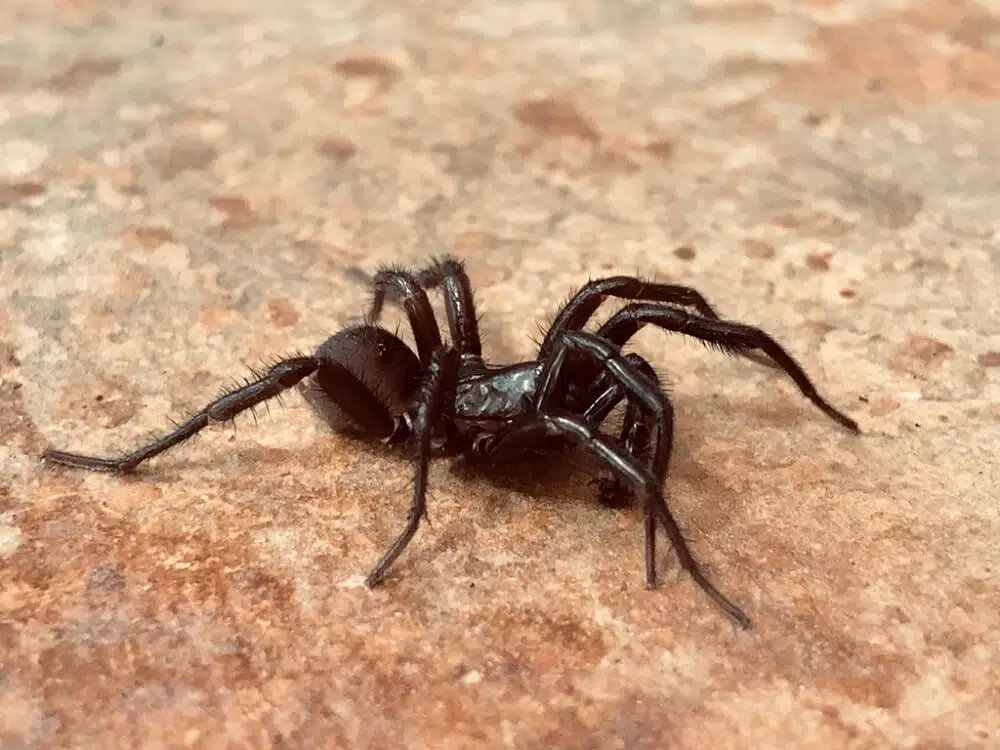
Scientific name: Antrodiaetus pacificus
Common name: pacific foldingdoor spider
Females are around 13mm long and males around 11 mm
They live in cool, humid wooded areas, constructing their burrows in soft soils, sand, moss, or rotting wood, where they lay their eggs and shelter during the winter.
During the day, the entrance to the burrow will be sealed, but after sunset, they open it up to sit and wait for a beetle or other insect to pass by so they can pounce on it.
23. Cat-faced Orbweaver

Scientific name: Araneus gemmoides
Common name: jewel spider, cat-faced spider, cat-faced orbweaver
With their distinctively cute cat-like faces, these spiders make their webs near external lights, enclosed spaces, and on the sides of buildings
They are found in varying colors, which change according to the season. What makes them easily identifiable are the two ‘horns’ on their abdomens.
24. Grey Cross Spider

Scientific name: Larinioides sclopetarius
Common name: bridge spider or gray cross spider, grey cross spider
This is a large orb-weaver. Females can achieve a body length of 10-14mm, with males at 8-9mm. Their orb webs can be up to 70 cm in diameter.
As the grey cross spider is attracted to light sources, it is often found in heavily-populated urban areas, to the point where these can be considered saturated with these spiders.
25. Bronze Jumping Spider

Scientific name: Eris militaris
Common name: bronze jumper or bronze lake jumper, bronze jumping spider
This common jumping spider lives around homes and in fields and woods. It tends to go unnoticed be overlooked due to its small size. Its bronze-brown color, though beautiful when examined close-up, acts as great camouflage against a whole range of backgrounds.
You’re most likely to spot bronze jumpers in the fall, crawling outside or even inside buildings. They can sometimes be found under the bark of dead trees where they aggregate to overwinter.
26. Six-spotted Orbweaver

Scientific name: Araniella displicata
Common name: Six-spotted orbweaver
Adult females measure 4-8mm in length, while males only reach 6mm.
It is unusual among orb-weavers, which generally spin huge webs. The horizontal web of the six-spotted orbweaver might only be 6-8cm in diameter, perhaps only the width of a single leaf. However, this is enough to trap long-legged flies or other insects that move from leaf to leaf.
27. Eurasian Running Crab Spider

Scientific name: Philodromus dispar
Common name: philodromid crab spider, eurasian running crab spider
This spider is about 5mm long; females are variable in size and color. The male is a lustrous black or dark brown with white flanks.
It’s found on trees and bushes where it preys on flies and other insects. An agile hunter it can run sideways as the name suggests.
It doesn’t construct a web but hunts its prey by remaining stationary in ambush and awaiting the approach of unwary victims.
28. Grey House Spider

Scientific name: Badumna longinqua
Common name: grey house spider
Grey House Spider females can reach up to 15mm, while males are typically around 11mm.
As the name suggests these spiders live almost exclusively in human habitats, rather than in the wild. The fact that it can adapt to a wide range of climates has helped it thrive, spreading from its native New Zealand to several countries, including the USA, where it is also found in woodland and grassy areas, as well as on grapevines.
They weave chaotic webs around window frames or any undisturbed spots around the home.
As a ladder web spider, the female will continue to add to her web over time, and it will become increasingly messy. She will typically live in a burrow close by, emerging at night to tend to her web and sit in wait for a passing meal.
29. Colonus hesperus
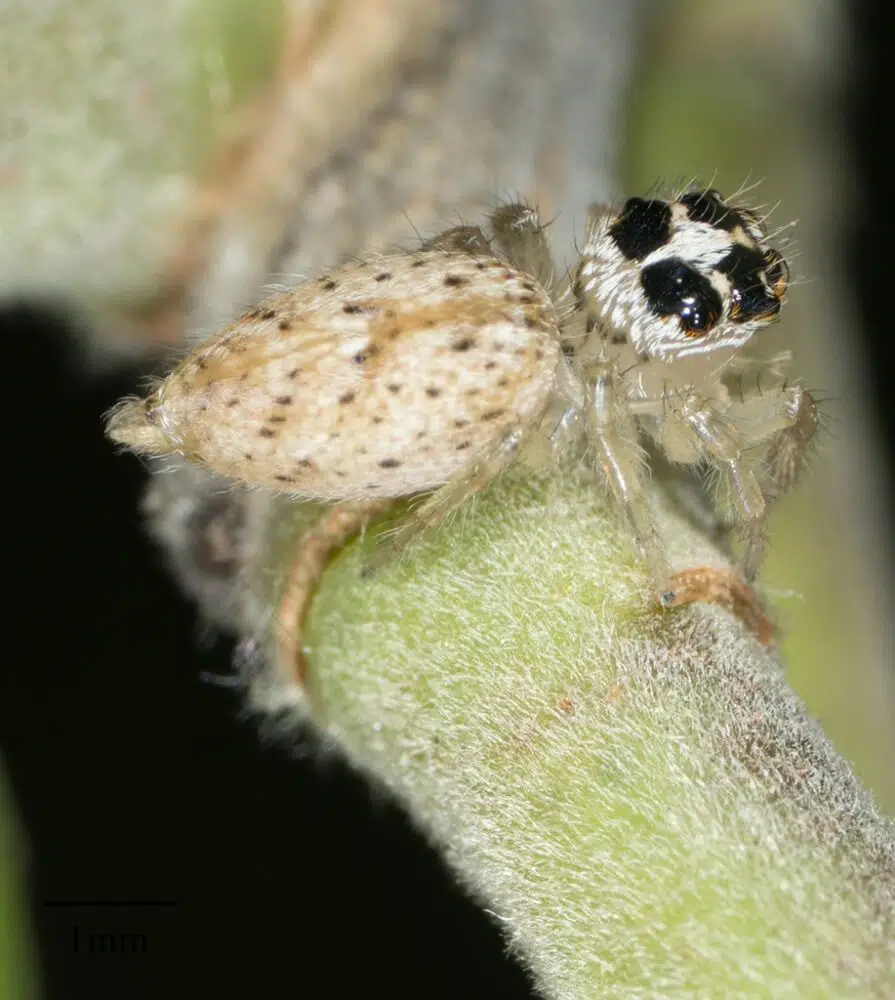
These small jumping spiders are 7mm or less in length. They can be identified by their yellow abdomen covered in black spots.
They appear to live in trees and are most abundant in May.
Like many jumping spiders they are shy and will run away when they feel threatened. They appear to have excellent eyesight and are skilled hunters, preying on smaller insects.
30. Barn Funnel Weaver

Scientific name: Tegenaria domestica
Common name: Domestic House Spider (in Europe), barn funnel weaver
The female is typically between 7.5-11.5 mm and the male 6–9 mm long.
Barn funnel weavers are skilled hunters, using their vision, their speed, and their webs to trap their prey. Six of their eyes point forward, which helps them to locate potential targets. They are especially photosensitive and will move towards or run away from light, depending on the situation.
They tend not to move continuously forward. Instead, they stop at short intervals, as if considering which direction to go in.
In addition to hunting actively, this spider builds funnel-shaped web, and sits deep inside. When vibrations alert it to the presence of a potential meal, it darts out, seizes its victim, and drags it back inside for consumption.
If it is threatened, it will typically curl up into a ball. These spiders are timid, but on the rare occasions when they’re panicked into biting a human, they’re unable to break the skin.
31. Tangleweb Spiders

Scientific name: Genus Theridion
Common name: tangle-web spiders, cobweb spiders and comb-footed spiders
Worldwide, there are 2200 species of Tangle Web Spiders. They’re known for constructing 3-D space webs (aka cobwebs).
Certain Tangleweb spiders, which can often be identified by their triangular bodies are known as ‘kleptoparasitic’. This means that they spend their lives in the webs of bigger spiders, consuming the smaller prey they find caught there.
On occasion, they may also eat the threads of the host’s web and even eat the host themselves.
32. Sierra Dome Spider

Scientific name: Neriene litigiosa
Common name: sierra dome spider
The small, horizontal sheet-weaving Sierra Dome Spider has a body length of 5mm-8mm
Found in open busy areas and at the edges of woodland, they hang underneath their non-sticky web until small prey, such as flies, midges, and leafhoppers land on it to rest. At which point they come up and bite it from underneath
33. Hobo Spider

Scientific name: Eratigena agrestis
Common name: hobo spider
Hobo spiders can be very varied in appearance, making identification difficult. For example, they can range from 7mm to 14mm in length.
They build horizontal webs, resembling trampolines, near woodpiles or brick walls where they can sit in safety and wait for prey.
Despite many legends related to the aggression of the hobo spider and the danger of its bite for humans, there is little evidence to support either. In fact, in 2017 the CDC removed the Hobo spider from its list of venomous species.
34. Brilliant Jumping Spider

Scientific name: Phidippus clarus
Common name: brilliant jumping spider
In common with many jumping spiders, the brilliant jumper has a distinctive rectangular-shaped carapace.
The brilliant jumping spider tends to live in mature fields. To hunt, it sits upside down near the top of a plant. When it senses prey nearby, it quickly jumps down to seize it, before it has a chance to escape. It can handle insects up to the size of an adult earwig.
35. Western Parson Spider
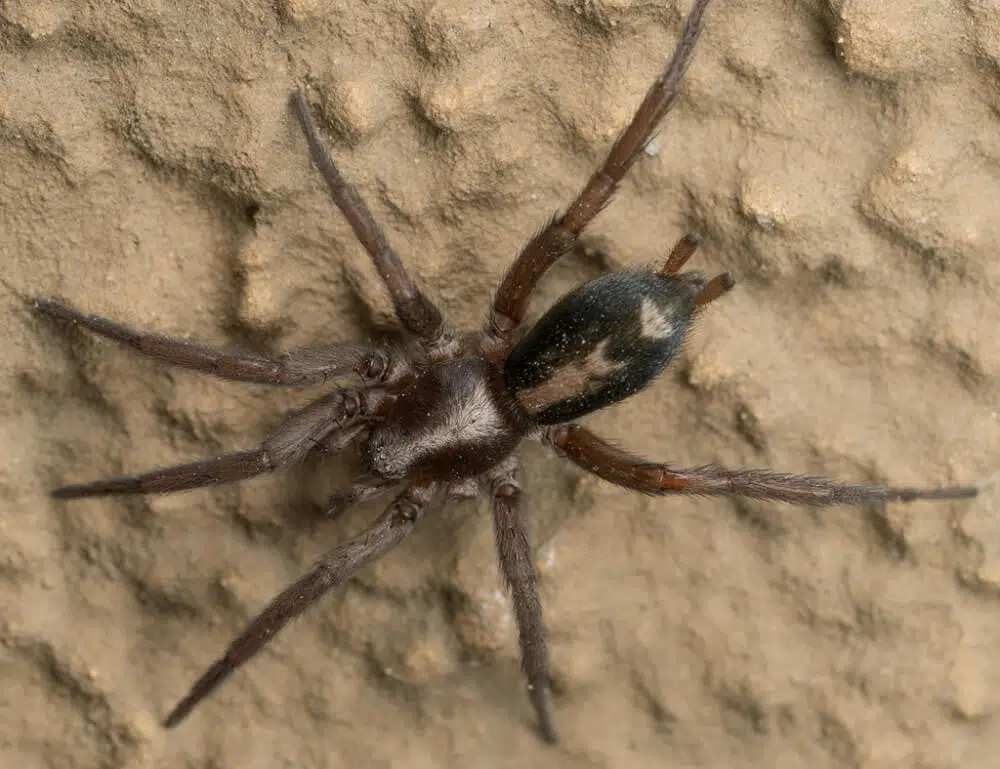
Scientific name: Herpyllus propinquus
Common name: western parson spider
Females are typically 8 to 13mm, while males average around 6mm in length.
Like other ground spiders, western parson spiders are nocturnal hunters. During the day, they conceal themselves under leaves, piles of wood, and stones. They move fast, in a zig-zag fashion, so can be hard to follow.
They occasionally enter homes to hibernate in winter.
36. Conical Trashline Orbweaver

Scientific name: Cyclosa conica
Common name: conical trashline orbweaver
These fascinating spiders are quite small, with females ranging from 5.3 to 7.5 mm, and males from 3.6 mm to 4 mm.
They are not typical orb-weavers. They’re easy to recognize as they create strings of dead insects and other debris to hang from the center of their web. They then hid on the string, well-disguised by their coloration- unless they move they’re almost invisible. This helps keep them safe from predators, as well as attract prey. If they’re threatened, they play dead.
Another way to identify their web is by the two vertical stripes which run down the middle.